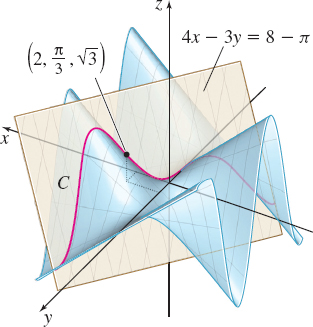EXAMPLE 2Interpreting the Directional Derivative as a Slope
Find the directional derivative of f(x,y)=xsiny at the point (2,π3) in the direction of a=3i+4j. Interpret the result as a slope.
Solution To find a directional derivative of a function f in the direction of a, where a is a nonzero vector, we must first find the unit vector in the direction of a. The unit vector u in the direction of a is u=a‖
The partial derivatives of f f_{x}(x,y)=\sin y\qquad \hbox{and}\qquad f_{y}(x,y)=x\cos y
are continuous throughout the plane, so f is differentiable. Using the unit vector \mathbf{u}=\dfrac{3}{5}\mathbf{i}+\dfrac{4}{5}\mathbf{j=}\cos \theta \mathbf{\mathbf{i}+}\sin \theta \mathbf{{j}}, we find 

At the point \left( 2,\dfrac{\pi }{3}\right), \begin{equation*} D_{\mathbf{u}}f\!\left( 2,\frac{\pi }{3}\right) =\dfrac{3}{5}\sin \dfrac{\pi }{3}+\dfrac{4}{5}\!\left( 2\cos \dfrac{\pi }{3}\right) =\dfrac{3}{5}\!\left( \frac{\sqrt{3}}{2}\right) +\dfrac{8}{5}\!\left(\dfrac{1}{2}\right)=\frac{3\sqrt{3}+8}{10} \end{equation*}
The slope of the tangent line to the curve C that is the intersection of the surface f( x,y) =x\sin y and the plane perpendicular to the xy-plane that contains the line through the point \left( 2,\dfrac{\pi }{3}, 0\right) in the direction \mathbf{a} is approximately 1.32. See Figure 4.